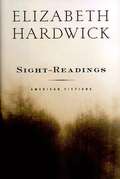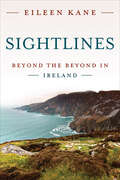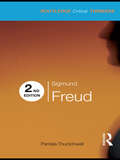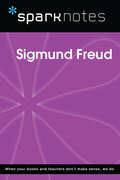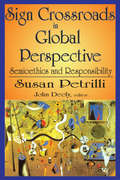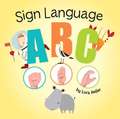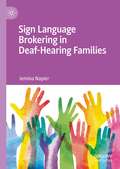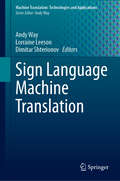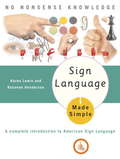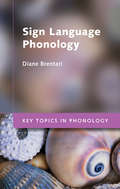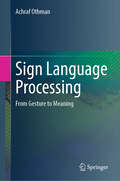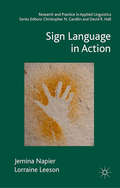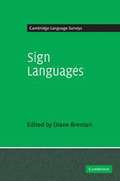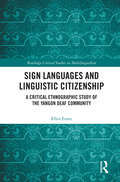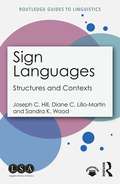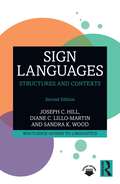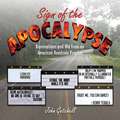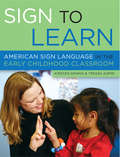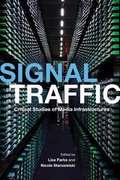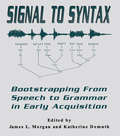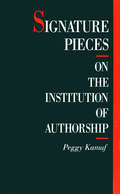- Table View
- List View
Sight-Readings: American Fictions
by Elizabeth HardwickIt is only in a country where newness and change and brevity of tenure are the common substance of life," wrote Henry James, "that the fact of one's ancestors having lived for a hundred and seventy years in a single spot would become an element of one's morality." Newness and rootedness are the twin poles of Sight-Readings, Elizabeth Hardwick's brilliant new collection of essays. (Her first, Seduction and Betrayal, was nominated for the National Book Award.) Hardwick's focus here is on American writers, at home and abroad, and especially women, as writers and as characters: Edith Wharton, Djuna Barnes, Gertrude Stein, Mary McCarthy, Elizabeth Bishop, Katherine Anne Porter, and Joan Didion, among others. In sections on Old New York, Americans Abroad, and Fictions of America, Hardwick considers writers and their landscapes, real and imagined. Her essays on Edith Wharton and Henry James illuminate aspects of their inventions of New York. From there she takes us to the Paris of Gertrude Stein and Djuna Barnes, into the hermetic world of Boston Transcendentalism, and on to the suburbs of John Cheever, the America of Philip Roth and John Updike, and the restless expanses of Richard Ford and the Prairie poets. Elizabeth Hardwick has achieved a permanent place in American letters for her sharp and elegant criticism. Her essays on American writers are themselves a work of literature.
Sightlines: Beyond the Beyond in Ireland
by Eileen KaneIt is the 1960s, and Ireland is hoping to join what will later become the European Union. The government has devised a plan to stem emigration and save the Irish language by supporting small factories in the Gaeltacht, traditional Irish-speaking villages in remote western areas. But is the plan working? With her signature humor and charm, Eileen Kane transports the reader to County Donegal with a detailed account of rural Irish life during this period of rapid change. This is a story about people living beyond the margins of maps, boundaries, language groups, and government departments – people bound by borders that have little or no correspondence to their own cultural, economic, and historical margins. Ultimately, it is a story about life on the edges, and the places and people who fall outside them.
Sigmund Freud (Routledge Critical Thinkers)
by Pamela ThurschwellThe work of Sigmund Freud has penetrated almost every area of literary theory and cultural studies, as well as contemporary culture. Pamela Thurschwell explains and contextualises psychoanalytic theory and its meaning for modern thinking. This updated second edition explores developments and responses to Freud’s work, including: tracing contexts and developments of Freud’s work over the course of his career exploring paradoxes and contradictions in his writing focusing on psychoanalysis as an interpretative strategy, paying special attention to its impact on literary and cultural theory examining the recent backlash against Freud and arguing for the continued relevance of psychoanalysis. Encouraging and preparing readers to approach Freud’s original texts, this guide ensures that readers of all levels will find Freud accessible, challenging and of continued relevance.
Sigmund Freud (SparkNotes Biography Guide)
by SparkNotesSigmund Freud (SparkNotes Biography Guide) Making the reading experience fun! SparkNotes Biography Guides examine the lives of historical luminaries, from Alexander the Great to Virginia Woolf. Each biography guide includes:An examination of the historical context in which the person lived A summary of the person&’s life and achievements A glossary of important terms, people, and events An in-depth look at the key epochs in the person&’s career Study questions and essay topics A review test Suggestions for further reading Whether you&’re a student of history or just a student cramming for a history exam, SparkNotes Biography guides are a reliable, thorough, and readable resource.
Sign Crossroads in Global Perspective: Semiotics and Responsibilities
by Susan PetrilliLanguage is the species-specific human version of the animal system of communication. In contrast to non-human animals, language enables humans to invent a plurality of possible worlds; reflect upon signs; be responsible for our actions; gain conscious awareness of our inevitable mutual involvement in the network of life on this planet; and be responsibly involved in the destiny of the planet. The author looks at semiotics, the study of signs, symbols, and communication as developing sequentially rather than successively, more synchronically than diachronically. She discusses the contemporary phenomenon that people in today's society have witnessed and participated in, as part of the development of semiotics. Although there is a long history preceding semiotics, in a sense the field is, as a phenomenon, more "of our time" than of any time past. Its leading figures, whom Petrilli examines, belong to the twentieth and twenty-first century. Semiotics is associated with a capacity for listening. This capacity is also the condition for reconnecting to and recovering the ancient vocation of semiotics as that branch of medical science relating to the interpretation of signs or symptoms. The pragmatic aspect of global semiotics studies the impact of language or signs on those who use them, and looks for consequences in actual practice. In this respect, Petrilli theorizes that the task for semiotics in the era of globalization is nothing less than to take responsibility for life in its totality.
Sign Language ABC
by Lora HellerBold and bright, hip and cool, this striking ABC book is like none other: each page teaches children the American Sign Language alphabet through a combination of letters, hand spelling, and adorable illustrations.
Sign Language Brokering in Deaf-Hearing Families
by Jemina NapierThis book details a study of sign language brokering that is carried out by deaf and hearing people who grow up using sign language at home with deaf parents, known as heritage signers. Child language brokering (CLB) is a form of interpreting carried out informally by children, typically for migrant families. The study of sign language brokering has been largely absent from the emerging body of CLB literature. The book gives an overview of the international, multi-stage, mixed-method study employing an online survey, semi-structured interviews and visual methods, to explore the lived experiences of deaf parents and heritage signers. It will be of interest to practitioners and academics working with signing deaf communities and those who wish to pursue professional practice with deaf communities, as well as academics and students in the fields of Applied Linguistics, Intercultural Communication, Interpreting Studies and the Social Science of Childhood.
Sign Language Interpreting: Deconstructing the Myth of Neutrality (Gallaudet Studies In Interpret Ser. #9)
by Melanie MetzgerAs with all professional interpreters, sign language interpreters strive to achieve the proper protocol of complete objectivity and accuracy in their translation without influencing the interaction in any way. Yet, Melanie Metzger's significant work Sign Language Interpreting: Deconstructing the Myth of Neutrality demonstrates clearly that the ideal of an interpreter as a neutral language conduit does not exist. Metzger offers evidence of this disparity by analyzing two videotaped ASL-English interpreted medical interviews, one an interpreter-trainee mock interview session, and the other an actual encounter between a deaf client and a medical professional. Sign Language Interpreting relies upon an interactional sociolinguistic approach to ask fundamental questions regarding interpreter neutrality. First, do interpreters influence discourse, and if so, how? Also, what kind of expectations do the participants bring to the event, and what do the interpreters bring to discussions? Finally, how do their remarks affect their alignment with participants in the interaction? Using careful assessments of how these interviews were framed, and also re-interviewing the participants for their perspectives, this penetrating book discloses the ways in which interpreters influence these situations. It also addresses the potential implications of these findings regarding sign language interpretation in medical, educational, and all other general interactions. Interpreter trainers and their students will join certified interpreters and Deaf studies scholars in applauding and benefiting from the fresh ground broken by this provocative study.
Sign Language Machine Translation (Machine Translation: Technologies and Applications #5)
by Lorraine Leeson Andy Way Dimitar ShterionovThis book, for the first time, collects important current topics in the area of sign language translation in a single volume. The topic is introduced more generally to benefit newcomers to the field before diving into the current state-of-the-art methods of Sign Language Machine Translation (SLMT), together with an in-depth description of issues specific to this topic, including: an introduction to and historical overview of SLMT; ethical issues related to the engagement of and with deaf users; the importance of data; the sign languages of Europe; sign language recognition and synthesis, including via avatars; data-driven and linguistically-informed models of SLMT; gloss translation; fingerspelling; SLMT communication; and SLMT in practice. Of interest to MT developers and users as well as people working in deaf studies, this volume presents cutting-edge research on machine translation in the field of deaf studies.
Sign Language Made Simple
by Karen LewisSign Language Made Simple will include five Parts:Part One: an introduction, how to use this book, a brief history of signing and an explanation of how signing is different from other languages, including its use of non-manual markers (the use of brow, mouth, etc in signing.)Part Two: Fingerspelling: the signing alphabet illustrated, the relationship between signing alphabet and ASL signsPart Three: Dictionary of ASL signs: concrete nouns, abstractions, verbs, describers, other parts of speech-approx. 1,000 illustrations. Will also include instructions for non-manual markers, where appropriate.Part Four: Putting it all together: sentences and transitions, includes rudimentary sentences and lines from poems, bible verses, famous quotes-all illustrated. Also, grammatical aspects, word endings, tenses.Part Five: The Humor of Signing: puns, word plays and jokes.Sign Language Made Simple will have over 1,200 illustrations, be easy to use, fun to read and more competitively priced than the competition. It's a knockout addition to the Made Simple list.
Sign Language Phonology (Key Topics in Phonology)
by Diane BrentariA concise overview of key findings and ideas in sign language phonology and its contributions to related fields, including historical linguistics, morphology, prosody, language acquisition and language creation. Working on sign languages not only provides important new insights on familiar issues, but also poses a whole new set of questions about phonology, because of the use of the visual communication modality. This book lays out the properties needed to recognize a phonological system regardless of its modality. Written by a leading expert in sign language research, the book describes the current state of the field and addresses a range of issues that students and researchers will encounter in their work, as well as highlighting the significant impact that the study of sign languages has had on the field of phonology as a whole. It includes lists of further reading materials, and a full glossary, as well as helpful illustrations that demonstrate the important aspects of sign language structure, even to the most unfamiliar of readers. A text that will be useful to both specialists and general linguists, this book provides the first comprehension overview of the field.
Sign Language Processing: From Gesture to Meaning
by Achraf OthmanIn a world where communication is key to human connection, understanding, and learning from one another, the book investigates the rich and intricate world of sign languages, highlighting the fascinating complexities of visual-spatial languages and their unique role in bridging the gap between hearing and deaf communities through information and communication technology. The book takes a journey through the evolution of sign language processing tools while exploring the cutting-edge techniques used to decipher, analyze, and process them, from the fundamentals of sign language structure and the nuances of non-manual signals to the latest developments in computational linguistics (corpora design, annotation tools, and notation systems), sign language recognition, and machine/deep learning applications. With a mission to reveal the silent language of expression, the author provides a captivating and thought-provoking look into a world often overlooked yet teeming with life and meaning. Offering a comprehensive and engaging overview of the current state of sign language research as well as its prospects, this monograph is an introduction resource for computer scientists, linguistics, educators, academics and sign language interpreters alike. This monograph is an invitation to discover the incredible potential of sign languages to transform human communication, promote inclusivity, and shape the future of technology. The readers will gain a deeper appreciation of the beauty and complexity of sign languages through technology, and they will be inspired to embrace the power of visual communication in our increasingly diverse and interconnected world.
Sign Language in Action (Research and Practice in Applied Linguistics)
by Jemina Napier Lorraine LeesonThis book defines the notion of applied sign linguistics by drawing on data from projects that have explored sign language in action in various domains. The book gives professionals working with sign languages, signed language teachers and students, research students and their supervisors, authoritative access to current ideas and practice.
Sign Languages
by Diane BrentariThis series offers general accounts of the major language families of the world, with volumes organized either on a purely genetic basis or on a geographical basis, whichever yields the most convenient and intelligible grouping in each case. Each volume compares and contrasts the typological features of the languages it deals with. It also treats the relevant genetic relationships, historical development, and sociolinguistic issues arising from their role and use in the world today. The books are intended for linguists from undergraduate level upwards, but no special knowledge of the languages under consideration is assumed. Volumes such as those on Australia and the Amazon Basin are also of wider relevance, as the future of the languages and their speakers raises important social and political issues.
Sign Languages and Linguistic Citizenship: A Critical Ethnographic Study of the Yangon Deaf Community (Routledge Critical Studies in Multilingualism)
by Ellen FooteThis critical ethnographic account of the Yangon deaf community in Myanmar offers unique insights into the dynamics of a vibrant linguistic and cultural minority community in the region and also sheds further light on broader questions around language policy. The book examines language policies on different scales, demonstrating how unofficial policies in the local deaf school and wider Yangon deaf community impact responses to higher level interventions, namely the 2007 government policy aimed at unifying the country’s two sign languages. Foote highlights the need for a critical and interdisciplinary approach to the study of language policy, unpacking the interplay between language ideologies, power relations, political and moral interests and community conceptualisations of citizenship. The study’s findings are situated within wider theoretical debates within linguistic anthropology, questioning existing paradigms on the notion of linguistic authenticity and contributing to ongoing debates on the relationship between language policy and social justice. Offering an important new contribution to critical work on language policy, the book will be of particular interest to students and scholars in sociolinguistics, linguistic anthropology and language education.
Sign Languages: Structures and Contexts (Routledge Guides to Linguistics #13)
by Joseph C. Hill Diane C. Lillo-Martin Sandra K. WoodSign Languages: Structures and Contexts provides a succinct summary of major findings in the linguistic study of natural sign languages. Focusing on American Sign Language (ASL), this book: offers a comprehensive introduction to the basic grammatical components of phonology, morphology, and syntax with examples and illustrations; demonstrates how sign languages are acquired by Deaf children with varying degrees of input during early development, including no input where children create a language of their own; discusses the contexts of sign languages, including how different varieties are formed and used, attitudes towards sign languages, and how language planning affects language use; is accompanied by e-resources, which host links to video clips. Offering an engaging and accessible introduction to sign languages, this book is essential reading for students studying this topic for the first time with little or no background in linguistics.
Sign Languages: Structures and Contexts (Routledge Guides to Linguistics)
by Joseph C. Hill Sandra K. Wood Diane C. Lillo-MartinSign Languages: Structures and Contexts provides a succinct summary of major findings in the linguistic study of natural sign languages. Focusing on American Sign Language (ASL), this book offers a comprehensive introduction to the basic grammatical components of phonology, morphology, and syntax with examples and illustrations.Revised throughout, this new edition: demonstrates how sign languages are acquired by Deaf children with varying degrees of input during early development, including no input where children create a language of their own discusses the contexts of sign languages, including how different varieties are formed and used, attitudes toward sign languages, and how language planning affects language use includes a new chapter on the similarities between signed and spoken languages offers additional visuals and explanations as well as more coverage of signed languages other than ASL is accompanied by updated online support material, which hosts links to video clips This engaging and accessible introduction to sign languages is essential reading for students studying this topic for the first time with little or no background in linguistics.
Sign of Pathology: U.S. Medical Rhetoric on Abortion, 1800s–1960s (RSA Series in Transdisciplinary Rhetoric #1)
by Nathan StormerMuch of the political polarization that grips the United States is rooted in the so-called culture wars, and no topic defines this conflict better than the often contentious and sometimes violent debate over abortion rights. In Sign of Pathology, Nathan Stormer reframes our understanding of this conflict by examining the medical literature on abortion from the 1800s to the 1960s. Often framed as an argument over a right to choose versus a right to life, our current understanding of this conflict is as a contest over who has the better position on reproductive biology. Against this view, Sign of Pathology argues that, as it became a medical problem, abortion also became a template, more generally, for struggling with how to live—far exceeding discussions of the merits of providing abortions or how to care for patients. Abortion practices (and all the legal, moral, and ideological entanglements thereof) have rested firmly at the center of debate over many fundamental institutions and concepts—namely, the individual, the family, the state, human rights, and, indeed, the human. Medical rhetoric, then, was decisive in cultivating abortion as a mode of cultural critique, even weaponizing it for discursive conflict on these important subjects, although the goal of the medical practice of abortion has never been to establish this kind of struggle. Stormer argues that the medical discourse of abortion physicians transformed the state of abortion into an indicator that the culture was ill, attacking itself during and through pregnancy in a wrongheaded attempt to cope with reproduction.
Sign of the Apocalypse: Ruminations and Wit from an American Roadside Prophet
by John GetchellFriends, neighbors, and passersby from all over the country can’t fail to miss “The Sign’s constantly changing humor and insight. On occasion, The Sign of the Apocalypse (SOTA) traffics in the earnest, but at its heart is rooted in a deep-seated desire to express the sarcastic and snort-worthy. This, and a love of haiku, pizza, Latin, double entendre, and the worst puns ever crafted. Two years in the making, the message on “The Sign” is changed on a daily basis, with the primary benefit of slowing passing traffic to a honking crawl. It was designed to convey pithy tidbits of thought and wordplay. In its conception, SOTA was perpetrated in spite of the objection of the author's girlfriend, and with hopes of creating controversy and dismay in the local community. The girlfriend packed up and left, and the community and town fathers were surprisingly gruntled by the proceedings. Punny and sarcastic signs include: • When attacked by a gang of clowns, go for the juggler • What if doing the hokey pokey really is what it’s all about? • Legalize marinara • A penny saved is ridiculous • Wendy, please take me back / I’m so miserable / it’s almost like / you’re still here
Sign to Learn
by Kirsten Dennis Tressa AzpiriEveryone is talking about signing with young children. As a form of early communication for infants and toddlers, or as a transitioning tool for children just beginning to speak, the benefits of signing with hearing children are endless.Sign to Learn is the first complete introduction to sign language curriculum for hearing preschoolers. In this unique resource, you will learn how to integrate American Sign Language (ASL) into your classroom to enhance the academic, social, and emotional development of children, and how to respectfully introduce children to Deaf culture.This comprehensive, fully illustrated curriculum contains captivating activities and lesson plans grouped by themes, including feelings, food, seasons, animals, songs, and families. Sign to Learn also contains strategies for using sign language with children with special needs and in multilingual classrooms, and it describes how ASL can assist you in developing a literacy program and in managing your classroom.Information-rich appendices include a thorough ASL illustration index, sample letters to families, and resources for further reading.
Signal Traffic: Critical Studies of Media Infrastructures (The Geopolitics of Information)
by Nicole Starosielski Lisa ParksThe contributors to Signal Traffic investigate how the material artifacts of media infrastructure--transoceanic cables, mobile telephone towers, Internet data centers, and the like--intersect with everyday life. Essayists confront the multiple and hybrid forms networks take, the different ways networks are imagined and engaged with by publics around the world, their local effects, and what human beings experience when a network fails. Some contributors explore the physical objects and industrial relations that make up an infrastructure. Others venture into the marginalized communities orphaned from the knowledge economies, technological literacies, and epistemological questions linked to infrastructural formation and use. The wide-ranging insights delineate the oft-ignored contrasts between industrialized and developing regions, rich and poor areas, and urban and rural settings, bringing technological differences into focus. Contributors include Charles R. Acland, Paul Dourish, Sarah Harris, Jennifer Holt and Patrick Vonderau, Shannon Mattern, Toby Miller, Lisa Parks, Christian Sandvig, Nicole Starosielski, Jonathan Sterne, and Helga Tawil-Souri.
Signal to Syntax: Bootstrapping From Speech To Grammar in Early Acquisition
by James L. Morgan Katherine DemuthIn the beginning, before there are words, or syntax, or discourse, there is speech. Speech is an infant's gateway to language. Without exposure to speech, no language--or at most only a feeble facsimile of language--develops, regardless of how rich a child's biological endowment for language learning may be. But little is given directly in speech--not words, for example, as anyone who has ever listened to fluent conversation in an unfamiliar language can attest. Rather, words and phrases, or rudimentary categories--or whatever other information is required for syntactic and semantic analyses to begin operating--must be pulled from speech through an infant's developing perceptual capacities. By the end of the first year, an infant can segment at least some words from fluent speech. Beyond this, how impoverished or rich an infant's representations of input may be remains largely unknown. Clearly, in the debate over determinants of early language acquisition, the input speech stream has too often been offhandedly dismissed as a potential source of information.This volume brings together internationally-known scholars from a range of disciplines--linguistics, psychology, cognitive and computer science, and acoustics --who share common interests in how speech, in its phonological, prosodic, distributional, and statistical properties, may encode information useful for early language learning, and how such information may be deciphered by very young children. These scholars offer a spectrum of viewpoints on the possibility that aspects of speech may provide bootstraps for language learning; contribute important, state-of-the-art findings across a variety of relevant domains; and illuminate critical directions for future inquiry. The publication of this volume represents a significant step in renewing the bonds between two fields that have long been sundered--speech perception and language acquisition.
Signalling Nouns in English
by John Flowerdew Richard W. ForestSignalling nouns (SNs) are abstract nouns like 'fact', 'idea', 'problem' and 'result', which are non-specific in their meaning when considered in isolation and specific in their meaning by reference to their linguistic context. SNs contribute to cohesion and evaluation in discourse. This work offers the first book-length study of the SN phenomenon to treat the functional and discourse features of the category as primary. Using a balanced corpus of authentic data, the book explores the lexicogrammatical and discourse features of SNs in academic journal articles, textbooks, and lectures across a range of disciplines in the natural and social sciences. The book will be essential reading for researchers and advanced students of semantics, syntax, corpus linguistics and discourse analysis, in addition to scholars and teachers in the field of English for academic purposes.
Signature Pieces: On the Institution of Authorship
by Peggy KamufSome contemporary approaches to literature still accept the separation of historical, biographical, external concerns from formal, internal ones. On the borderline that lends this division between inside and outside its apparent coherence is signature. In Peggy Kamuf’s view, studying signature will help us to rediscover some of the stakes of literary writing beyond the historicist/formalist opposition. Drawing on Derrida’s extensive work on signatures and proper names, Kamuf investigates authorial signature in key writers from Rousseau to Woolf, as well as the implications of signature for the institutions of authorship and criticism.
